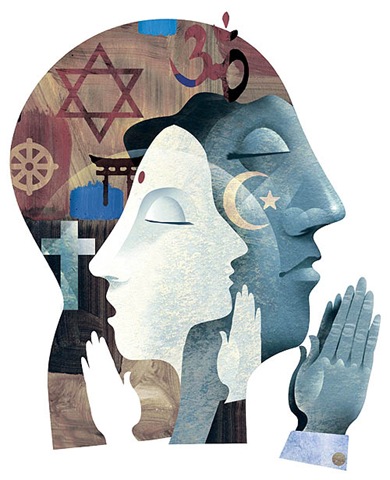
Samuel Huntington’s thesis which he argued that next phase of conflict in the world would be based on the cultural competitive interaction; but the counter thesis claimed that tolerance is the key – teaching of any religion to cope with the inevitable struggle. Being a tolerant need to be accommodating and flexible to other religion to give space to think independently and live harmoniously with the rest of the world.
Therefore, learning and empowering from each other encourage the survival of the human race in nuclear-armed nations whose vested interest is on the threshold to get chance to use it. But it is our collective effort to negotiate with them for world peace.
None of the religion is complete unless it has dialogue and interactions among various groups. Christianity, Islam, Hinduism, Jainism, Buddhism, Judaism are the main faiths on the world. The so-called protector of these religions always claimed that religion is adamant and unalterable, but the socio-economical conditions of their followers changed. Priests of all religion borrowed many philosophical concepts, rituals, customs, and myths, from each other – a sign of tolerance itself. Why can not we practice it today?
The ancient Egyptian religious traditions still survive and continue to influence many religions. Their tradition of tombs to preserve the mortal remains of great people spread from Egypt to Rome, where many of the first Christians convert Egyptian slaves. They influence Christians and Islamic burials in later times. The traditions of magnificent tombs for great kings and nobleman are unknown in Arabia but came to India with the Persian influence.
In modern times, King Fahd of Saudi Arabia was buried in a simple unmarked grave. Skull caps are now common among Jewish and Muslim worshipers but the practice probably began with the Magi priests of ancient Persia to prevent human hair falling into the sacred fire and contaminating it. Many Egyptian elements are found in Roman Catholicism. T
he word Pope is derived from Pharaoh while his crown is the same shape as the twin crown of the Pharaohs and the style of the pope’s shepherd’s crop and flail across the chest is almost identical to representations of the Pharaohs.
The worship of Mary or the concept of a mother and child was alien to Jewish or the early Christian tradition but the Egyptian cult of Isis and her beloved son Horos was copied as it appeared to the multitude of Egyptian slave in ancient Rome. The idea of the Medonna only became catholic dogma in 1854 AD. The festival of Christmas was unheard of in early Christianity but the priests were unable to discourage the popular Roman rites of Saturnalia of the winter fest.
Priests always ready to take control of other faiths including some of the older traditions of paganism that they claimed to abhor, created the myth of Christ’s nativity to continue the popular winter festival. They were quite willing to accommodate alien tradition as long as the followers remained subject to their control. To control the social behavior is a key function of any religion.
The Greek Orthodox Church only believed in the Father and Son, while Roman Catholics believed in the Father, Son and Holy Ghost. Early Christians like Jews, had abhorred all graven images including crucifix. When Portuguese came to India almost from the time of Christ were appalled by the crucifix, portraits, and statues that the catholic visitors carried in complete violation of the early tenets of Christianity. The Portuguese regarded them as heretics and tried to force them to adopt their version of Christianity.
Although Islam is considered a religion based on the revelation received by Muhammad, the Quran and Hadith contain a huge baggage of Jewish and Christian ideas, beliefs and customs along with a huge baggage of ancient Arab traditions like Eid and Ramzan that long predate Muhammad.
Competitive rituals also crept into all religions. If Muslims recited 99 names of Allah, 99 or 108 names of Vishnu became a similar chant for many Hindus. Shias had their Muharram procession so B Tilak began the Ganesh Chaturti processions in Maharashtra a century ago to unite Hindus in similar festive parades. A Hindu Navaratra similarly may have been inspired by a pre-Islamic Persian Nauroz that later became part of Shia custom and marks the summer and autumn equinox. It is significant that these dates are based on the solar calendar even though all other Hindu festivals follow the lunar calendar.
Perhaps the worst competition is sound pollution caused by loudspeakers perhaps beginning with the Muslim Azzan was soon a part of the loud sounds emanating from loudspeakers at every other place of worship. The tradition of a Muezzin calling the faithful to prayer dated from the time of Muhammad but the scriptures of no religion requires electronic amplification of the prayers or sermon in their places of worship. An omnipresent God is not deaf and will surely hear prayers of every worshiper. Loudspeakers are not for the religious but are tools of competitive religiosity leads to communal dispute.



